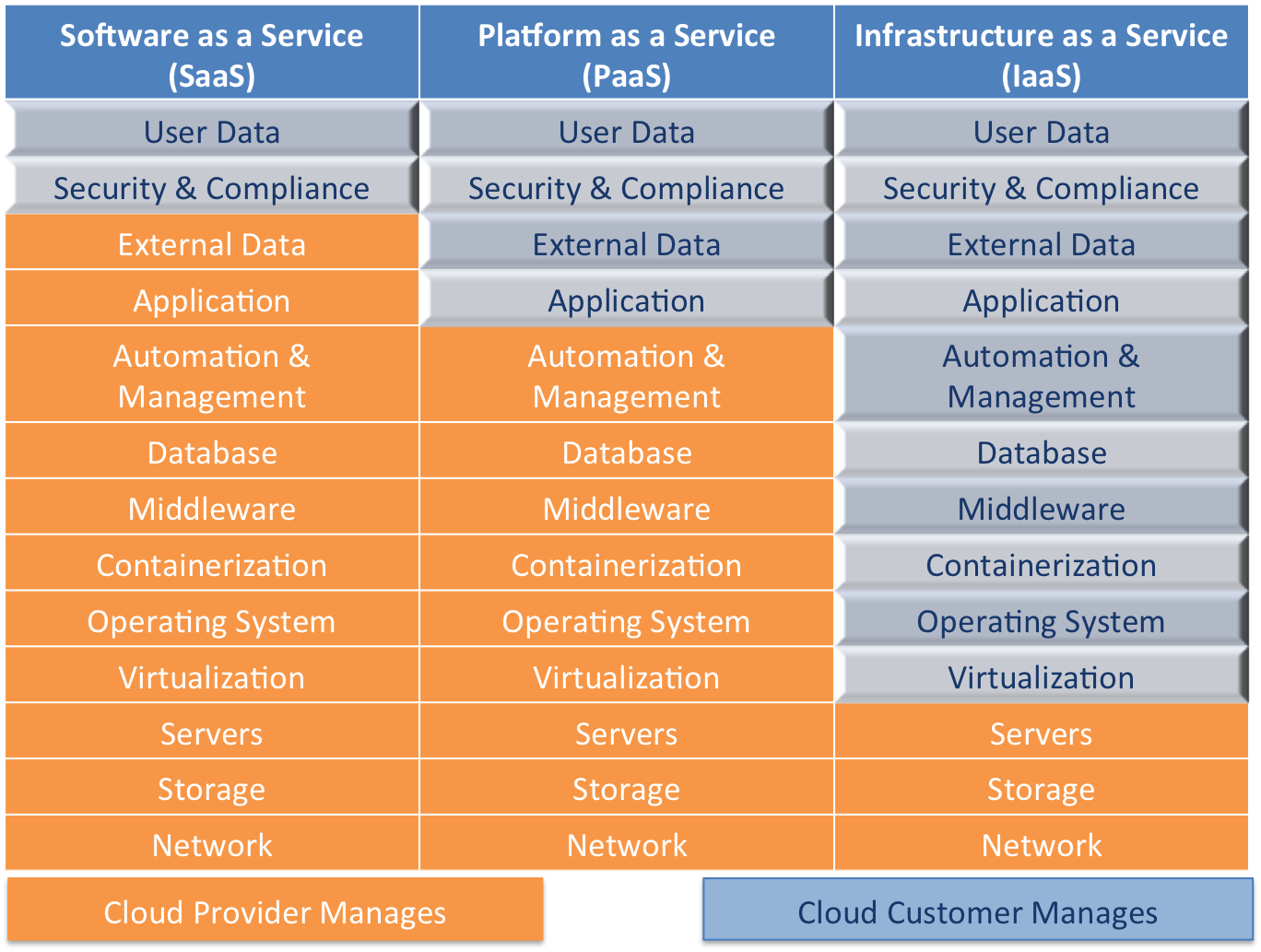Premise
This document covers Wikibon’s definition of public cloud. It is a companion piece to Wikibon’s 2016 Public Cloud update http://wikibon.com/wikibon-2016-public-cloud-forecast-update/. Due to its increasingly central role in delivering IT services and its disruptive nature, definitions vary considerably from vendor to vendor. Our definition aligns with the NIST definition, but acknowledges public cloud vendor revenue reports of their public cloud business.
Public Cloud Overview
Cloud is a disruptive technology changing the face of enterprise IT. By providing infrastructure services (IaaS), applications service (SaaS) and platform services (PaaS), cloud service providers are changing IT procurement from capital investment to operational expenditure, and allowing traditional IT to be by-passed. As the Internet of Things grows; as Internet data streams become a larger proportion of enterprise data processing; the locus of IT will shift closer to the public cloud, and reduce the friction for IT adoption. Wikibon expects public clouds to comprise about one third of total enterprise IT spend by 2026. Wikibon expects that this move will have significant impact on traditional IT hardware and software vendors.
Cloud Definition
Users and vendors have varying definitions of what they mean by “cloud”. For consistency, we have mapped our public cloud definition to conform to the NIST definition (from Wikipedia). The National Institute of Standards and Technology’s definition of cloud computing identifies “five essential characteristics” which Wikibon adheres to in this study:
- On-demand self-service – A consumer can unilaterally provision computing capabilities, such as server time and network storage, as needed automatically without requiring human interaction with each service provider.
- Broad network access – Capabilities are available over the network and accessed through standard mechanisms that promote use by heterogeneous thin or thick client platforms (e.g., mobile phones, tablets, laptops, and workstations).
- Resource pooling – The provider’s computing resources are pooled to serve multiple consumers using a multi-tenant model, with different physical and virtual resources dynamically assigned and reassigned according to consumer demand.
- Rapid elasticity – Capabilities can be elastically provisioned and released, in some cases automatically, to scale rapidly outward and inward commensurate with demand. To the consumer, the capabilities available for provisioning often appear unlimited and can be appropriated in any quantity at any time.
- Measured service – Cloud systems automatically control and optimize resource use by leveraging a metering capability at some level of abstraction appropriate to the type of service (e.g., storage, processing, bandwidth, and active user accounts). Resource usage can be monitored, controlled, and reported, providing transparency for both the provider and consumer of the utilized service.
Of course, users and vendors may not be so exacting in their internal definitions of what “cloud” means to them. However, we are confident that our data closely correlate to the definitional framework above.
Cloud Deployment Models
This report focuses on public cloud vs. private and hybrid (or composite) markets. Wikibon follows the NIST guidelines about the types of cloud offerings. Wikibon will be reporting on private and hybrid (composite) cloud markets in subsequent research.
- Public
- Provisioned for open use by the general public.
- May be owned, operated, and managed by an organization and it exists on the premises of the provider.
- Cloud-based application is fully deployed in the cloud and is managed and run in the cloud.
- Could be developed and/or migrated from an existing internal IT datacenter.
- Private/On-premises
- Provisioned for exclusive use by a single organization. It may be owned, managed, and operated by a third party as well as the single organization itself. It may exist on or off premise.
- Using virtualization and resource management tools for greater infrastructure and management efficiency and flexibility when the application is best deployed.
- Hybrid – Cloud infrastructure is a composite of two or more distinct cloud infrastructures (private, community, or public) that remain unique entities, but are bound together by technology that enables data and application portability.
Why Public Cloud?
Simply put, “Cloud computing allows computer users to conveniently rent access to fully featured applications, to software development and deployment environments, and to computing infrastructure assets such as network-accessible data storage and processing” (NIST)
While all forms of cloud (and legacy solutions for that matter) have their place, the unique value of public cloud (as opposed to private and hybrid cloud) is characterized by:
- On-demand usage and pricing
- Global reach
- High scalability
- Resource elasticity
- Rapidly growing set of features and services
- Capital cost avoidance
- Access to realtime and continual online application upgrades
- Ability to rapidly deploy new applications
Public Cloud Segment Definitions
In this study, Wikibon is using the following as the definition (See Figure 1) of the architectural differentiation of SaaS, PaaS, and IaaS.

Source: © Wikibon 2015
The operational distinctions between SaaS, PaaS, and IaaS are described below:
Software-as-a-Service (SaaS)
- SaaS enables remote access of applications running as a cloud service, without directly provisioning or managing any of the middleware or infrastructure.
- Configuration is limited to user-specific configuration settings (e.g., bandwidth in and out of the cloud, performance tiers, data capacity, compliance report options, simple modification of input/output naming, etc.).
- SaaS runs on a fully integrated IaaS, either provided by the SaaS provider or sitting on an IaaS provider (e.g., AWS).
- The SaaS enterprise user is responsible for only user data, for security/compliance, and for managing specific configuration settings and managing service level agreements (SLAs).
- The advantages of SaaS for the user include lower investment and faster initial time to value, and faster access to application improvements.
- The advantages of SaaS for ISVs include lower support costs and faster time to value for both initial deployments and continuous updates.
- There are 100s of SaaS vendors including Salesforce.com, Microsoft Dynamics and O365, Cisco Webex, Workday, ServiceNow, Athenahealth, among many others. SaaS offerings by Oracle, IBM, SAP, and Cisco were primarily via acquisitions.
- Some SaaS providers such as ServiceNow and Saleforece.com via Force.com provide a PaaS service on top of their SaaS service (see PaaS below)
Infrastructure-as-a-Service (IaaS)
- IaaS provides enterprises with the ability to provision computing, storage, networking, and many other software services including database services, virtualization, load-balancing, security, development tools, automation, management and operations.
- Wikibon includes middleware and database services as part of IaaS, which leads to a clear distinction and definition illustrated in Figure 1 above. This is different from the definition used by some database vendors. If this becomes a significant segment, Wikibon will look at creating a separate segment of the public cloud market.
- The services are offered on demand or on a committed schedule.
- IaaS can be used to run application development, enterprise applications moved to the cloud and as IaaS services for SaaS providers.
- Examples include Amazon Web Services (AWS), Microsoft Azure, Google Compute Engine, IBM Cloud, VMware vCloud Air, Rackspace and others.
Platform-as-a-Service (PaaS)
- PaaS is a full application life-cycle cloud service, including initial development, testing, deployment, operations, and maintenance. It is well suited to modern continuous integration and delivery development models.
- PaaS (including IaaS) can be delivered as an integrated platform on public, private, and hybrid clouds, either integrated with an IaaS platform (e.g., Pivotal Web Services, IBM Bluemix) or as a feature on top of an IaaS platform (e.g., AWS Elastic Beanstalk).
- PaaS can also be delivered on top of a SaaS platform as a set of services which utilize the underlying SaaS and IaaS infrastructure (e.g., Force.com on Salesforce.com).
- PaaS on IaaS and PaaS on SaaS are distinct and different deployment models. In addition, Business Process as a Service (BPaaS) is an emerging extension of PaaS on SaaS. Because of the small size of PaaS at the moment, Wikibon has combined these sub-segments. Wikibon will investigate in more detail in future research.
- The advantages of PaaS include quicker time to value and lower cost of development. The disadvantages include increased overhead and less control over performance and management of the underlying infrastructure layer.
- Examples of PaaS include Salesforce’s Force.com, Microsoft Azure, IBM Bluemix, Amazon’s Elastic Beanstalk, Pivotal Cloud Foundry, Google App Engine, Red Hat OpenShift, Apprenda, Apcera, Heroku, and others. Wikibon’s PaaS definition excludes standalone development services (DBaaS, testing, Middleware-as-a-Service) that are not part of a total Public Cloud application development bundle.
What We’re Counting
Wikibon counts public cloud revenue in the following manner:
- Public Cloud Only – Professional services, advertising-related, and other spending is excluded from this report. Advertising revenue may indeed become a factor in public cloud spending in the future, and Wikibon will consider including advertising revenue if and when it becomes a factor in how public cloud services are paid for.
- Enterprise and Consumer Spending – The overwhelming proportion of public cloud spending today is by enterprises. Wikibon expects that consumer-related cloud services – i.e., productivity, collaboration, content management, marketing-related from vendors like Facebook and Twitter – will need to be enterprise standard, and will be included in public cloud in the future. Wikibon will monitor this trend closely.
- Public Cloud Revenue Reports Caveat – Wikibon acknowledges that provider reporting of “public cloud” revenue seems to be in the eye of the beholder. Salesforce and AWS are pretty much pure public cloud plays, as are many start-up software vendors all of whom report public cloud revenue fairly clearly. However, the definition of “public cloud” becomes a bit murkier for non-pure-plays.
- Microsoft (Azure, Dynamics Online, O365 Commercial, O365 Consumer) and what % of each is actually public cloud resident.
- Oracle’s SaaS (organic growth vs. acquisition?) and PaaS figures vs. IaaS are challenging to unravel
- SAP’s Cloud designation – and organic vs. acquisition growth
- IBM’s very broad array of public and private cloud services span hardware, software, professional services, outsourcing services, analytics, etc.
However, in our view, this just indicates that public cloud is being leveraged from many different angles and is building significant momentum as it encompasses both product and service delivery mechanisms, pretty much penetrating into all aspects of information technology.


